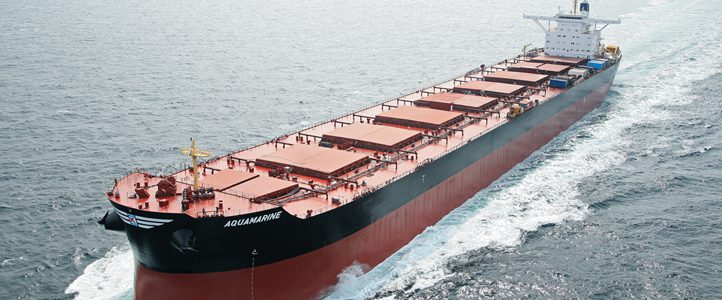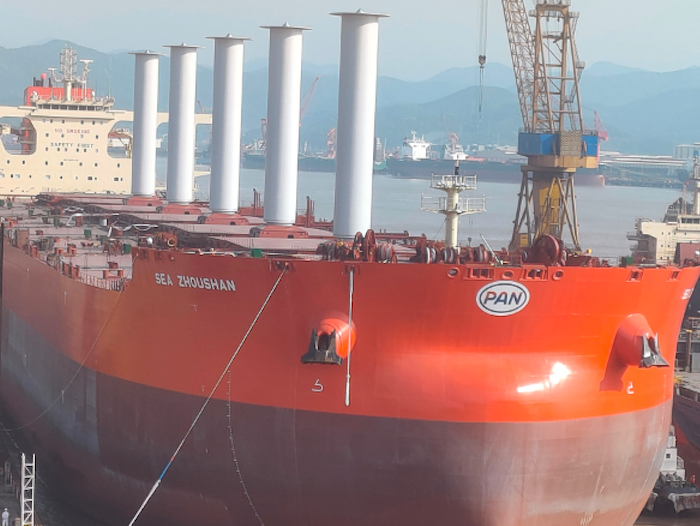Top Rated Valemax Advice
Posted: 13 Dec 2021 17:44
Seagoing Bulk Carriers: Purpose and General Use
Operation of sea-going bulk carriers posed a number of risks. Important shipboard issues require careful planning and caution. This site provides an instant reference for the an international shipping community, offering guidance and information on the loading and discharging of various bulk cargoes and to be within the restrictions according to the guidelines of the classification society. It is important to minimize the chance of stressing the structure of the ship and to follow all safety precautions for safe passage at sea. You might find useful information about bulk carrier topics in our detail pages that are geared towards those working on the sea as well as those working ashore.
The general characteristics of bulk ships that travel by sea.
Bulk carriers are single-deck vessels that are fitted with top-side tanks and side tanks. They are designed for single-commodity bulk cargo. Solid bulk cargo refers to any material other than liquids or gases comprised of a mix of granules and particles. It is possible to load directly into cargo spaces without any form of confinement. Dry cargo includes sugar, grains, and bulk ore. The broadest definition of the word bulk carrier, any ship built to carry bulk cargo (solid or liquid) in bulk are considered bulk carriers. Tankers also fall under the same umbrella. The term is used primarily to describe ships that carry bulk solid cargoes. This includes grains and similar agricultural products. Check out this bulk ship specialist for more.

What Is A Bulk-Carrier What Are The Most Important Characteristics Of Bulk Carriers:
"A ship which is intended primarily to carry dry cargo in bulk, including such types as ore carriers and combination carriers"
Carrying capacity ranging from 3,000 tonnes to 300,000.
-Average speed of 12 ~ 15 knots
-Single deck ships, ie no tweendecks
Carriers with medium to small size bulk (carrying capacity between 40 to 60,000 tonnes) typically come with equipment for handling cargo. However, larger vessels can use shore-based -facilities to load or unload.
Cargo storage is usually large and without any obstructions. There are hatches with larger sizes to allow cargoes to be easily loaded and unloaded.
The bulk carriers typically have one cargo space, which is devoted to ballast. It can be used to ballast voyages to increase stability. Two or three additional holds may be permissible to ballast in part at port, but only
-They can be covered with single pull or hydraulic or stacking (piggyback) style steel hatch covers
-Four types of ballast tanks:
Sloping topside wing tanks
Tanks with a sloping bottom
Double bottom tanks
Ballasts for peak and post peak water tanks
Are you searching for solid bulk cargo? Anything that isn't liquids or gases, made up of particles, granules, or larger chunks of material. They can be placed directly into cargo containers without any intermediary method of containment. The bulk carriers that transport cargo include "clean" food items as well as "dirty" minerals. They may react to each other as well as with contamination sources such water. This is why it is essential to prepare the cargo space to accommodate the particular cargo. It is important to clean the cargo space prior to load it. Surveyors are usually required to ensure that the space is ready for loading. To avoid contamination, it is essential to eliminate any remnants of a previous cargo. Water is the most significant cause of destruction to bulk cargoes. Therefore, it is crucial that storage areas are dry in order to allow cargo. Hatch covers should also be watertight in order to stop water from entering. All fittings in the storage areas (pipe guards and bilge covers etc.) must be inspected. It is crucial to examine every fitting in the hold (ladders and pipe guards etc.) and make sure they are correctly installed. They may cause serious wear and tear to conveyor belts, which could lead to delays. If the equipment is accidentally discharged by cargo, the vessel might be held liable. Have a look at this ore carrier specialist for more.

Bulk Carrier or Bulker? It is built to carry dry cargo. A typical bulk carrier has a single deck, single skin and double bottom. It also contains topside tanks, hopper side tanks, and cargo space tanks. Bulk carriers are able to load bulk cargo of any kind from heavy to light grain, up to their maximum deadweight. It isn't easy to load, transport and discharge dry bulk cargo.
Carrier for bulk materials without equipment
A lot of bulk cargoes may be dangerous or alter their properties in transit. Improper loading could result in damage to the ship, e.g. It is possible for the ship to bow if it is not properly loaded. This can cause the ship to'stress'. When the weather is rough it can lead to serious problems at sea. Remaining cargoes can also be affected by residues from other cargoes. Some bulk cargoes are also vulnerable to water damage. cement power. It can be challenging to establish the exact amounts and weights of the cargoes being loaded and unloaded. These variables can have significant effects on how bulk cargoes are handled safely. Discharging bulk cargo using? Bulk cargoes are prone to form a cone if they are loaded on conveyor belts. The angle of repose is known as "angle of repose" and is dependent on the particular cargo. Iron ore cargoes will form a steep-angled cone whereas cargoes that flow freely will create a cone with a shallow angle. A cargo that is low in angle of repose has the possibility of shifting during the passage. When cargo is nearing its completion, bulldozers could have been used to divide the load into holds. Dry-bulk carriers rely on shoreside facilities to load and discharge cargo, but bulk carriers are also able to self-unload with conveyors or cranes on deck.
Operation of sea-going bulk carriers posed a number of risks. Important shipboard issues require careful planning and caution. This site provides an instant reference for the an international shipping community, offering guidance and information on the loading and discharging of various bulk cargoes and to be within the restrictions according to the guidelines of the classification society. It is important to minimize the chance of stressing the structure of the ship and to follow all safety precautions for safe passage at sea. You might find useful information about bulk carrier topics in our detail pages that are geared towards those working on the sea as well as those working ashore.
The general characteristics of bulk ships that travel by sea.
Bulk carriers are single-deck vessels that are fitted with top-side tanks and side tanks. They are designed for single-commodity bulk cargo. Solid bulk cargo refers to any material other than liquids or gases comprised of a mix of granules and particles. It is possible to load directly into cargo spaces without any form of confinement. Dry cargo includes sugar, grains, and bulk ore. The broadest definition of the word bulk carrier, any ship built to carry bulk cargo (solid or liquid) in bulk are considered bulk carriers. Tankers also fall under the same umbrella. The term is used primarily to describe ships that carry bulk solid cargoes. This includes grains and similar agricultural products. Check out this bulk ship specialist for more.

What Is A Bulk-Carrier What Are The Most Important Characteristics Of Bulk Carriers:
"A ship which is intended primarily to carry dry cargo in bulk, including such types as ore carriers and combination carriers"
Carrying capacity ranging from 3,000 tonnes to 300,000.
-Average speed of 12 ~ 15 knots
-Single deck ships, ie no tweendecks
Carriers with medium to small size bulk (carrying capacity between 40 to 60,000 tonnes) typically come with equipment for handling cargo. However, larger vessels can use shore-based -facilities to load or unload.
Cargo storage is usually large and without any obstructions. There are hatches with larger sizes to allow cargoes to be easily loaded and unloaded.
The bulk carriers typically have one cargo space, which is devoted to ballast. It can be used to ballast voyages to increase stability. Two or three additional holds may be permissible to ballast in part at port, but only
-They can be covered with single pull or hydraulic or stacking (piggyback) style steel hatch covers
-Four types of ballast tanks:
Sloping topside wing tanks
Tanks with a sloping bottom
Double bottom tanks
Ballasts for peak and post peak water tanks
Are you searching for solid bulk cargo? Anything that isn't liquids or gases, made up of particles, granules, or larger chunks of material. They can be placed directly into cargo containers without any intermediary method of containment. The bulk carriers that transport cargo include "clean" food items as well as "dirty" minerals. They may react to each other as well as with contamination sources such water. This is why it is essential to prepare the cargo space to accommodate the particular cargo. It is important to clean the cargo space prior to load it. Surveyors are usually required to ensure that the space is ready for loading. To avoid contamination, it is essential to eliminate any remnants of a previous cargo. Water is the most significant cause of destruction to bulk cargoes. Therefore, it is crucial that storage areas are dry in order to allow cargo. Hatch covers should also be watertight in order to stop water from entering. All fittings in the storage areas (pipe guards and bilge covers etc.) must be inspected. It is crucial to examine every fitting in the hold (ladders and pipe guards etc.) and make sure they are correctly installed. They may cause serious wear and tear to conveyor belts, which could lead to delays. If the equipment is accidentally discharged by cargo, the vessel might be held liable. Have a look at this ore carrier specialist for more.

Bulk Carrier or Bulker? It is built to carry dry cargo. A typical bulk carrier has a single deck, single skin and double bottom. It also contains topside tanks, hopper side tanks, and cargo space tanks. Bulk carriers are able to load bulk cargo of any kind from heavy to light grain, up to their maximum deadweight. It isn't easy to load, transport and discharge dry bulk cargo.
Carrier for bulk materials without equipment
A lot of bulk cargoes may be dangerous or alter their properties in transit. Improper loading could result in damage to the ship, e.g. It is possible for the ship to bow if it is not properly loaded. This can cause the ship to'stress'. When the weather is rough it can lead to serious problems at sea. Remaining cargoes can also be affected by residues from other cargoes. Some bulk cargoes are also vulnerable to water damage. cement power. It can be challenging to establish the exact amounts and weights of the cargoes being loaded and unloaded. These variables can have significant effects on how bulk cargoes are handled safely. Discharging bulk cargo using? Bulk cargoes are prone to form a cone if they are loaded on conveyor belts. The angle of repose is known as "angle of repose" and is dependent on the particular cargo. Iron ore cargoes will form a steep-angled cone whereas cargoes that flow freely will create a cone with a shallow angle. A cargo that is low in angle of repose has the possibility of shifting during the passage. When cargo is nearing its completion, bulldozers could have been used to divide the load into holds. Dry-bulk carriers rely on shoreside facilities to load and discharge cargo, but bulk carriers are also able to self-unload with conveyors or cranes on deck.